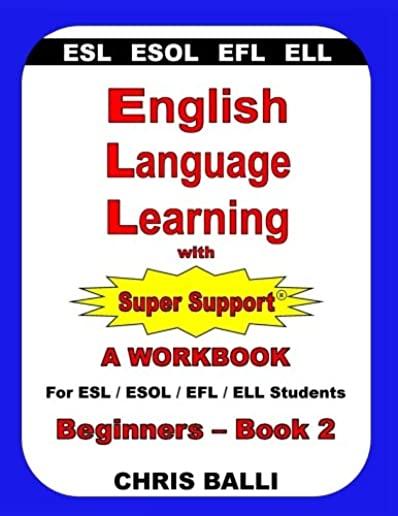
Balli, Chris
product information
description
8ESL Workbook 2 is CLASSROOM-READY and EASY-to-USE. All lessons are NO-PREP to LOW-PREP and are designed for beginning ESL / ESOL / EFL / ELL students who speak little or no English. The developmental lessons in this book progress in difficulty in tiny, incremental steps, and lessons are brimming with a wide variety of worksheets, drills, pictures, stories, spelling exercises, role-playing activities, vocabulary practice, quizzes, surveys, presentations, conversations, drama activities, and pair-speaking exercises. Topics covered include the high-interest subjects students love: sports, recreational activities, food, daily and weekly routines, and their likes and dislikes. Workbook 2 picks up where Workbook 1 leaves off and begins with the PRESENT CONTINUOUS TENSE in a chapter dealing with sports and recreation themes. The SIMPLE PRESENT TENSE is then introduced and studied extensively. These topics are within the grammar lessons in the following chapters: SPORTS AND RECREATION, POSSESSIVE ADJECTIVES, SIMPLE PRESENT AFFIRMATIVE, SIMPLE PRESENT NEGATIVE, and SIMPLE PRESENT INTERROGATIVE. Beginning ESL / ESOL / EFL / ELL students have significant difficulty with the affirmative, the negative, and the interrogative in the SIMPLE PRESENT TENSE. For example, a beginning student might rely on voice inflection to ask questions. The student might say, "She ride the bus," ending the statement with a high note, instead of "Does she ride the bus?" The negative might be said as "She no like...," instead of "She doesn't like..." The error for the third person singular is also apparent in these examples. Vocabulary such as DO, DOES, DON'T and DOESN'T are not in the beginner's repertoire. For this reason, ample exercises and opportunities to use this vocabulary are provided. The beginner's language skills will show a marked improvement after the study of the SIMPLE PRESENT TENSE. The beginner's language skills will be more developed, and each student will be able to understand and to communicate much more effectively. The material in WORKBOOK 2 was written and developed to include the needs of students with minimal educational skills. These students might be illiterate or barely literate in their native languages, or they might have several years of schooling missing from their education. Ease and repetition are critical, so grammatical features are practiced in many different formats. A component to written exercises is that students are expected to also practice the content orally. Consequently, students are practicing writing, reading, listening, and speaking skills in a very controlled environment, so there is little room for error. The controlled exercises are then followed by authentic communication exercises where students are given an actual reason to communicate. For example, they might have to gather information from other students and present their findings to the class in a presentation. The intent of so much written and oral practice is that the student will internalize the grammatical feature that is being taught and then turn around and be able to use it naturally in normal, everyday situations. The UNIQUE feature of this book is the VOLUME of material included to teach every grammatical point presented so that students may practice them until they are mastered. Teachers will save time and energy from having to search for additional material to supplement problem spots because abundant LOW-PREP to NO-PREP material is provided in this book. Students will benefit by learning the material through constant repetition, practice, and use in a wide variety formats and activities that they enjoy. The material in this book has been proven to be highly effective in helping beginning ESL / ESOL / EFL / ELL students to learn and to speak English throughout the United States and in countries all over the world.
member goods
No member items were found under this heading.
Return Policy
All sales are final
Shipping
No special shipping considerations available.
Shipping fees determined at checkout.







